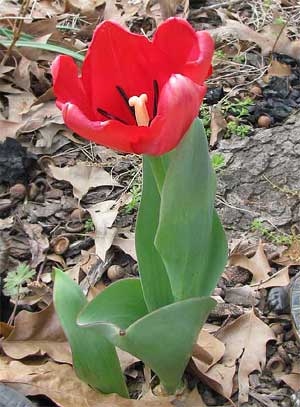 Tulips are members of the genus Tulipa, of the Lily Family, the Liliaceae. Though 150 or more wild tulip species are known (they grow wild from the Mediterranean region and across Asia to Japan), most garden tulips are mostly derived from two species, Tulipa gesneriana, and Tulipa suaveolens. Some other wild types sometimes contribute a little genetic material as well.
Tulips are members of the genus Tulipa, of the Lily Family, the Liliaceae. Though 150 or more wild tulip species are known (they grow wild from the Mediterranean region and across Asia to Japan), most garden tulips are mostly derived from two species, Tulipa gesneriana, and Tulipa suaveolens. Some other wild types sometimes contribute a little genetic material as well.
Below you see what's inside a typical tulip blossom. The white, cylindrical item with three little curved-back doodads atop it is the female pistil, as described on our Standard Blossom Page. The pistil is topped by a 3-lobed stigma. Most of the white, cylindrical part below the stigma is the ovary. The somewhat narrowed zone between the stigma and ovary is the style, which in most flower types is easier to make out than in tulip flowers.
 The slender, black items radiating from the base of the pistil are male stamens. In this flower nearly the entire stamens consist of black, pollen-filled anthers. The hardly-visible, paler "stems" below the anthers are filaments which, again, in most flower types are more obvious than among the tulips. Tulip flowers have one pistil arising in their centers, with 6 stamens arising from around the pistil's base. This makes tulip flowers classic examples of superior ovaries.
The slender, black items radiating from the base of the pistil are male stamens. In this flower nearly the entire stamens consist of black, pollen-filled anthers. The hardly-visible, paler "stems" below the anthers are filaments which, again, in most flower types are more obvious than among the tulips. Tulip flowers have one pistil arising in their centers, with 6 stamens arising from around the pistil's base. This makes tulip flowers classic examples of superior ovaries.
With tulip flowers, instead of speaking of the calyx and corolla, we use the special term perianth, which is used to mean the calyx and corolla considered together, when the two things are not clearly distinguishable. In other words, the "sepals" look just like the "petals." Therefore, we can say that the perianth segments of the flower in the picture are red, with black bases.
Garden tulips come in such variety and are so pretty and interesting that special words have come into use just for talking about them. These include:
- "Botanical tulips" are those species other than the above-mentioned Tulipa gesneriana and Tulipa suaveolens
- "Selfs" or "breeders" are tulip blossoms in solid colors
- "Broken" blossoms are those with mixed colors
- "Bybloems" are blossoms with the under color being white, with markings of lilac or purple
- "Bizarres" are blossoms with an under color of yellow, and markings of red to brown
